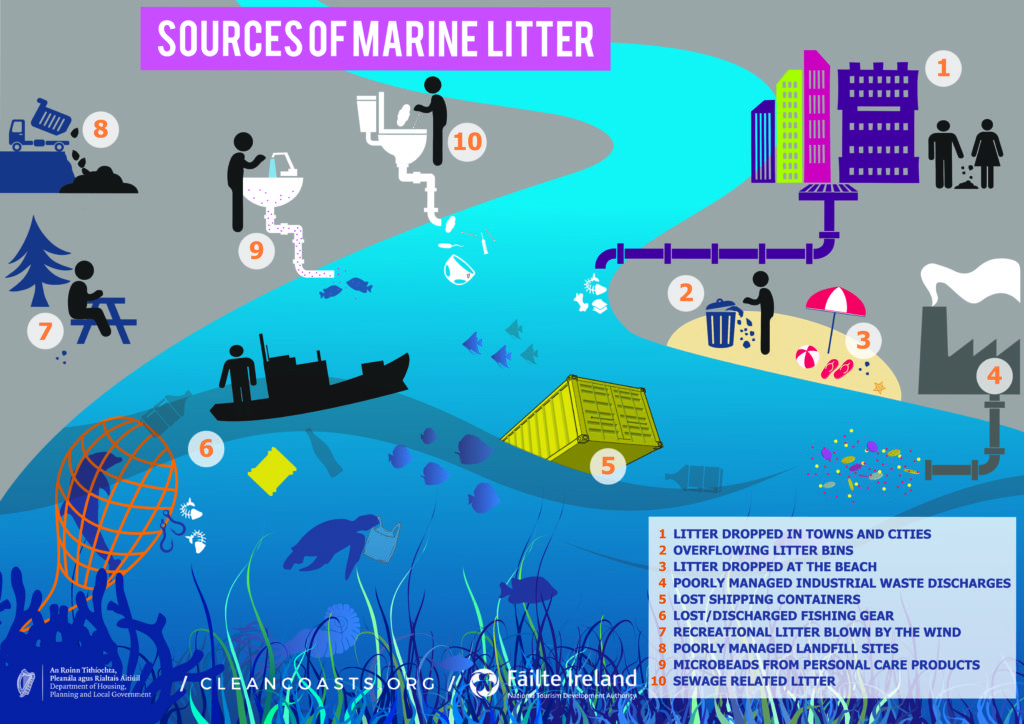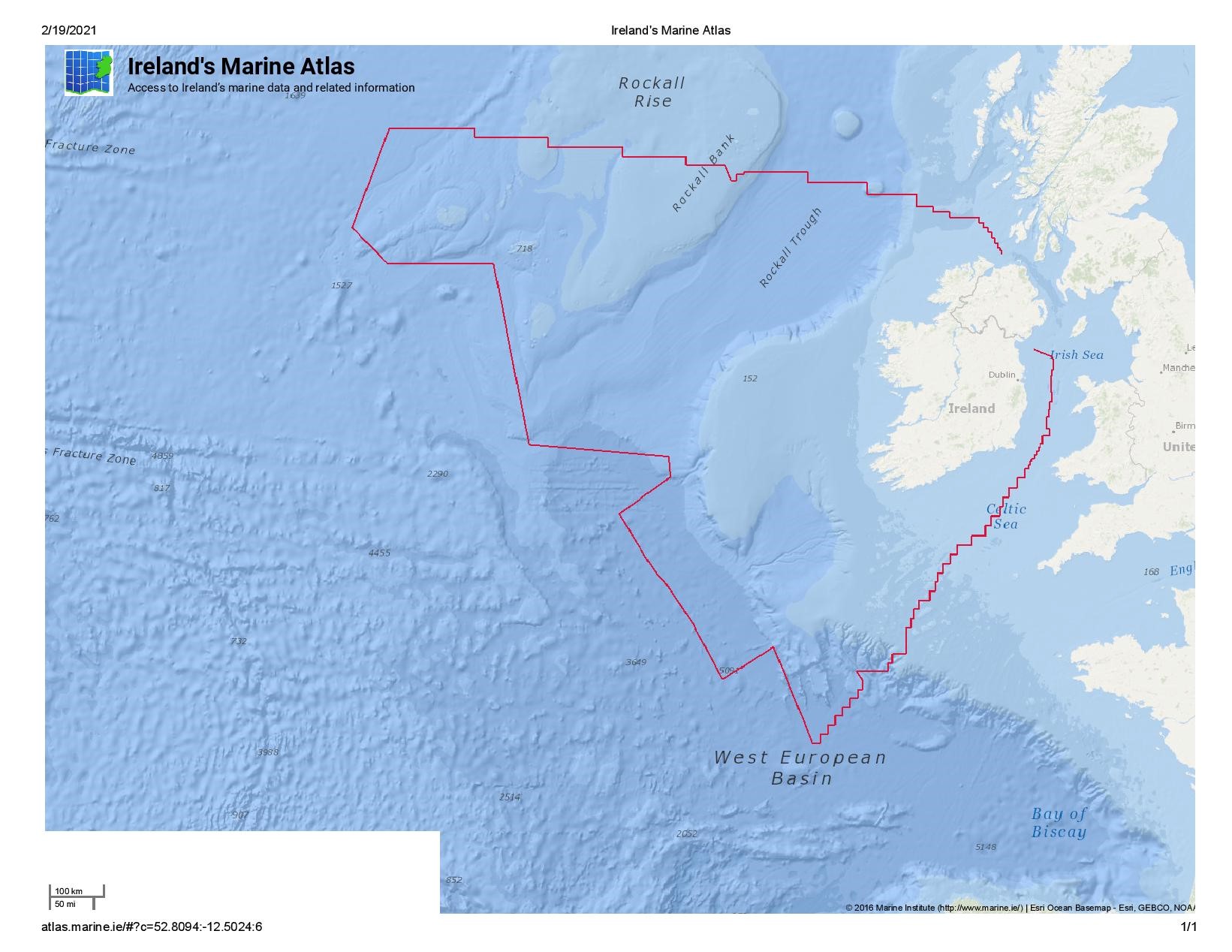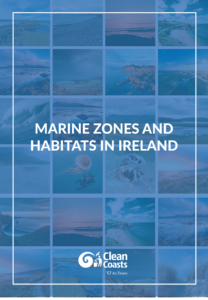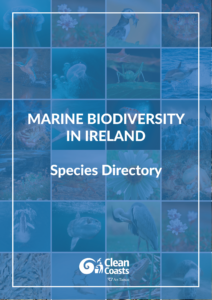Marine Biodiversity in Ireland
An overview of Marine Biodiversity in Ireland, including information on coastal habitats, threats, solutions, and current legislation.

In Ireland, we are fortunate to have a spectacular coastline and a vast marine territory that stretches out over 200 nautical miles past our landmass. This expansive area has many fascinating habitats, from the bustling rockpools of our rocky shoreline, out to the eery depts of the Porcupine Abyssal Plain. It is also teeming with life, playing host to 24 species of whales and dolphins, 35 species of sharks, 2 species of seals, 24 species of seabirds, over 250 species of marine plants and hundreds of species of fish and invertebrates.
Click on each of the buttons below to find out more about marine zones and habitats, ecosystems and what they do, threats and solutions and policy and legislations active in Ireland.
Marine Zones & Habitats
Our coastline and oceans are divided into zones. Coastal zones are areas of transition between land and sea, whereas Oceanic Zones are categorised by the Ocean’s depth and penetrating light levels.
Within these zones, exists a myriad of complex habitats and fascinating species. These habitats are some of the most complex and dynamic on earth, ranging from being fully emersed to fully submerged depending on their proximity to the shoreline. The dynamic nature of the ocean means in order to survive species must adapt to the avoid predation, changing levels in light, temperature, salinity, oxygen and pressure.
Let’s explore these zones and habitats a little further, from above the high tide line, right out to the edge of the continental shelf. The following habitat classifications are based on ‘A Guide to Habitats in Ireland’ (Fossitt, 2000).
Click on the image below to download our Marine Zones and Habitats directory.
Marine Biodiversity – Species Directory
Ireland’s coastline and marine environment is teeming with life, playing host to 24 species of whales and dolphins, 35 species of sharks, 2 species of seal, 24 species of seabirds, over 250 species of marine plants and hundreds of species of fish and invertebrates. Losing just one species from an ecosystem can have a detrimental impact on the whole community.
Click on the image below to download our Species directory.
Ecosystems and Marine Ecosystem Services
Marine species and their habitats form communities known as ecosystems. They connect through their feeding habits and these relationships can be illustrated in a food web, see example below.
Losing just one species from an ecosystem can have a detrimental impact on the whole community. For instance, looking at the food web below, if phytoplankton were removed, fish would lose a major source of nutrition, causing a decline in numbers. This would then have an impact on species numbers further up the food chain, resulting in the collapse of the ecosystem.

Productive and stable ecosystems not only benefit marine species, they are also essential for a healthy planet and ultimately our own existence.

such as phytoplankton and seaweeds during a process known as photosynthesis. During the same process, plants take in Carbon Dioxide (CO2) from the atmosphere in a natural fight against climate change.
Coastal habitats such as sand dunes and wetlands act as a buffer against high seas and storm impact.
Wetlands also act as a natural filter system, removing harmful waste from coastal waters.
In addition to these vital services, we also lean heavily on the oceans for:
- Industry
- Food
- Resources
- Transportation
- Wellbeing
- Tourism & recreation
Unfortunately, this reliance is ever increasing and threatening to collapse our marine wildlife communities.
Threats to Marine Biodiversity
The major threats to our marine environments are:
- Pollution and run-off from untreated sewage, litter, fertilisers, pesticides, industry.
- Marine litter causing harm to wildlife by entanglement, suffocation, ingestion, and habitat degradation.
- Overfishing
- Climate change related issues, e.g., ocean acidification, warming of marine waters and rising sea levels.
- The introduction of invasive species to fragile ecosystems
- Degradation associated with resource exploration, e.g., minerals, oil and gas.
- Unsustainable and inappropriate coastal development.
- Pressure on fragile coastal habitats caused by human recreation and activity.

What We Can Do To Help
We can address these issues and make small changes in our everyday lives to reduce our impact on the ocean and its inhabitants.
Here are a few ways you can make a change:
Divert litter away from harming wildlife and degrading habitats by removing it from our coastal and inland environments. The Clean Coasts programme encourages individuals and groups to register as a Clean Coasts Group to remove litter in your local area. Groups can also adopt an area to focus on litter management and ongoing care. Our grants scheme helps to support Clean Coasts Groups with environmental and improvement projects in their adopted areas.
If becoming a Clean Coasts Group doesn’t suit you, you can pledge to do a #2minutebeachclean to spend two minutes removing litter from our coast as you are out and about!
We use so many single-use plastics without even thinking about it, but these plastics don’t break down for hundreds of years and can harm wildlife and the environment. We can help by reducing the amount of single-use plastics and packaging we buy. Why not start by identifying three plastic items that you could reduce or replace with eco-friendly alternatives? Find some tips here.
We can impact the oceans and litter found around our coast from our bathrooms! As mentioned, there are many sources of marine litter and unfortunately the sewage system is one. We need to avoid flushing harmful items such as sanitary products, wipes and cotton buds to reduce our impact on the ocean. Find out more here.
Pouring fats, oils and grease (FOGS) down the drain can lead to blockages and overflows of sewage, causing damage to habitats and harming aquatic species. We can use a sink strainer to collect food before it goes down the sink and we can get rid of FOGs by letting them cool in a container and putting them in the compost or general waste bin. Find out more here.
As the famous diver and explorer Jacques Cousteau once said “people protect what they love” so if you submerge yourself in the marine environment and learn about its inhabitants, you’re more likely to want to help to protect it! You can learn about the coastland, seashore, seabed and marine water bodies on our habitat pages. Each habitat includes descriptions of the various plants and animals that occupy each area.
Policy & Legislations on Marine Biodiversity in Ireland
Under national and EU law we have a commitment to protect biodiversity in Ireland. Unfortunately, these safeguards are necessary as how we live as a society is causing habitat degradation and a decline species numbers. In Ireland the National Parks & Wildlife Service (NPWS) are responsible for the designation of conservation sites in Ireland. They work with the public to implement best practice in conserving nature.
Habitats and species are protected under:
Irish Law Designations
National Heritage Area – (NHA)
The basic designation for wildlife in Ireland is an NHA. An NHA is a protected area due to the type of habitats present or the species within them whose habitat need protection.
Natural Reserves
There is only one marine nature reserve in Ireland, Lough Hyne, Co. Cork. It is an area of importance for wildlife, which is protected under Ministerial order. Not all reserves are owned by the State, some are owned by organisations or private landowners.
EU Law Designations
Special Area of Conservation (SAC) under the EU Habitats Directive
The habitats and species within Special Area of Conservation sites are important not only from an Irish perspective but also at a European level. There are 159 marine SACs in Ireland including Dublin Bay and Cork Harbour. The Directive lists certain types of habitats and species that must be protected within an SAC. Marine habitats include sand dunes, machair, estuaries and inlets, and species include Salmon, Otter, and Bottlenose Dolphin.
Special Protected Area (SPA) under the EU Birds Directive
This designation is specific to the protection of birds and focuses on listed rare and vulnerable species, regularly occurring migratory species and wetland habitats especially those of international importance. Marine SPAs along the coast are vital to wintering birds as they are a source of food and protected marine waters are important to seabird colonies breeding along the coast.
For further information on protected sites in Ireland you can look up maps on the NPWS website here.
Marine Protected Area (MPA) under the EU Marine Strategy Framework Directive (MSFD)
There is currently no definition for an MPA in Irish law, however, the following operational definition of an MPA is proposed for sites in Ireland.
A geographically defined area of marine character or influence which is protected through legal means for the purpose of conservation of specified species, habitats or ecosystems and their associated ecosystem services and cultural values, and managed with the intention of achieving stated objectives over the long term.
To date there are no MPA sites in Ireland, however, the government have started the process of expanding Ireland’s network of Marine Protected Areas (MPAs). For up to date information on the MPA process please check this dedicated MPA government information page.



